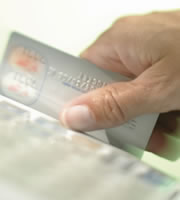A positive + a negative = stable credit card rates

October 15, 2012
Current averages:
- Average consumer credit card rate, overall market: 16.89 percent
- Average consumer non-rewards credit card rate: 15.15 percent
- Average consumer rewards credit card rate: 17.64 percent
- Average student credit card rate: 17.34 percent
- Average business non-rewards credit card rate: 14.74 percent
- Average business rewards credit card rate: 15.74 percent
Once again, the U.S. bank prime rate was unchanged at 3.25 percent.
In math and science, a negative and a positive will often cancel each other out. It can work the same way in finance and economics, especially since the flow of news stories is not usually overwhelmingly good or bad. Often, positive and negative developments cancel each other out, and that could be one explanation for why all the above categories of credit cards were unchanged in early October.
On the negative side, at the end of September the Bureau of Economic Analysis (BEA) released its final estimate of economic growth for the second quarter of 2012. The BEA now estimates that real GDP grew at an annual rate of just 1.3 percent in the second quarter. This is a downward revision from the previous estimate of 1.7 percent, and represents a slowing of the economy from the 2.0 percent real growth rate of the second quarter.
Bad news such as a weak GDP number can often push interest rates lower, both because of falling demand for credit and because it encourages the Federal Reserve to pursue (or in this case, continue) low interest rate policies. However, barely a week after the GDP announcement there was a contrasting update from the Bureau of Labor Statistics about unemployment. This release showed that unemployment dropped by 0.3 percent to 7.8 percent during September. This is a strong improvement for one month, and it broke the unemployment rate out of the narrow 8.1 percent to 8.3 percent range it had stubbornly clung to in the first eight months of the year.
So, with one development that would normally push rates lower and one that would tend to push them higher, perhaps it should be no surprise that credit card rates remained unchanged in early October. Another factor might be the uncertainty created by a close Presidential election. This might be enough to keep credit card companies in wait-and-see mode until late November.
Consumer credit cards
Consumer credit card offers have been unchanged over the past two months, creating a calm environment in which consumers can compare rates and choose the best non-rewards or rewards credit cards for their needs.
Student credit cards
As students head towards mid-terms, one thing they shouldn’t have to worry about is their credit card rate, since student credit cards have been unchanged since late August.
Business credit cards
Since business executives generally prefer making decisions in a atmosphere of stability, recent months have been well-suited to researching and choosing business credit cards. Rates for business rewards credit cards have not changed since late July, while rates for non-rewards business credit cards haven’t changed all year.
Good credit vs. average credit
Even when average credit card rates are frozen still, as they have been over the past six weeks, individual customers still have a couple of opportunities to lower their rates. One is to shop for rates, because within each category of credit cards there are significant differences between the highest and lowest rate offers. Another way customers can lower rates is by improving their credit ratings. Currently, among consumer credit card offers, there is a 3.83 percent difference between average rates and rates available to customers with the best credit. This rate differential is an example of the reward customers can expect for improving their credit ratings.
In total, IndexCreditCards.com surveys information from some 50 different credit cards, and includes multiple credit-rating tiers from many of those cards. Examples of offers surveyed include American Express, Capital One, Chase, Citi, Discover, and other MasterCard and Visa branded cards. The information compiled not only demonstrates trends in credit card rates over time, but also indicates the different values credit card companies put on different target markets (consumer, business, etc.), as evidenced by the differences between rates for those markets.
Disclaimer:The information in this article is believed to be accurate as of the date it was written. Please keep in mind that credit card offers change frequently. Therefore, we cannot guarantee the accuracy of the information in this article. Reasonable efforts are made to maintain accurate information. See the online credit card application for full terms and conditions on offers and rewards. Please verify all terms and conditions of any credit card prior to applying.
This content is not provided by any company mentioned in this article. Any opinions, analyses, reviews or recommendations expressed here are those of the author’s alone, and have not been reviewed, approved or otherwise endorsed by any such company. CardRatings.com does not review every company or every offer available on the market.
Published